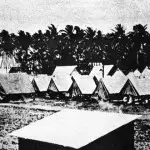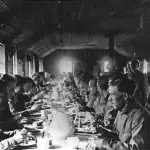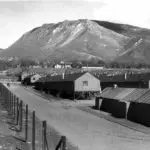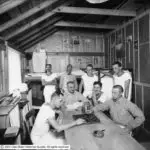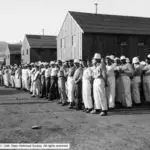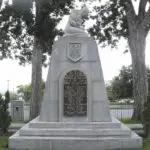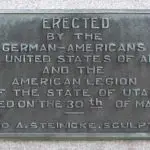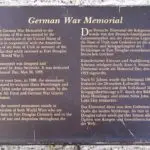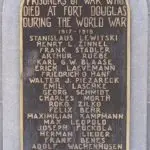The SMS Cormoran II Crew - Prisoners of War
Table of Contents
Share This
After more than two years of internment on the United States territory of Guam, the German cruiser SMS Cormoran II was scuttled by its crew in Apra Harbor on 7 April 1917 to prevent it becoming a spoil of war between the US and Germany. The scuttling made big news and was of great interest as well as the first shots fired by the US in World War I occurred at this time. However, interest in the crew of the SMS Cormoran II itself quickly dissipated. The headline-grabbing sinking of their own vessel made the front page of papers worldwide as the US prepared to send American troops into what was becoming the most horrific fighting yet seen in modern warfare. But, indeed, few seemed to care about some prisoners moving around the globe to a new prison. Perhaps then that is why most history books do not often discuss the men after the opening days of the war.
Journey from Guam to the US
The survivors of the explosion were immediately placed into special prisons. The crew was interned at Asan in what is today the War in the Pacific National Historical Park’s Asan Beach Unit. The area previously had been used as a prison for Filipino insurrectionists from 1901-1903 and was the one large open area suitable for such a mission that was also close to a United States Marine Corps encampment in the village. The officers were removed to Camp Barnett which sat at the end of a road on the lower slopes of Mount Tenjo. Dr. Gebhard, the Cormoran’s physician, was given a separate cabin for him and his new wife, US Navy nurse Eleanore Blain, to reside. The crew’s imprisonment in Guam would be extremely short—Guam just was not designed to hold over 300 prisoners of war.
Most of the military cargo, passengers, mail, etc. carried to and from Guam at that time was aboard US military ships operated by the Army. Even prior to the scuttling of the ship, members of the Cormoran crew were being transported stateside on the United States Army Transport’s (USAT) vessels for medical reasons. In 1915, Lieutenant Werner von Elpons had escorted two “insane” men and a patient with tuberculosis to California aboard USAT Logan. One of these men, Fritz Seigmeyer, was later deemed sane and soon after, he escaped from Mare Island Navy Yard on 14 September 1916. Seaman Heinrich Trompeter arrived at San Francisco aboard USAT Thomas on 18 March 1917 with a gangrenous foot which was to be removed at Mare Island, California. The USAT Thomas would be utilized again to transport the main body of the Cormoran crew to prison.
The crew departed Guam on 29 April 1917 just over three weeks after blowing up their ship. The Thomas traveled a route that left Guam, went to Manila, then Nagasaki, up to the Aleutians, and finally to San Francisco where it arrived on 8 June 1917. The ship’s manifest just lists the crew as “prisoners of war” and does not mention any of them by name. By the time the men arrived into San Francisco they were page six-news in an article that simply stated 32 officers and 289 men had arrived. The men were being transferred in special cars bound for Utah where they were to be imprisoned at Fort Douglas.
The men of the Cormoran were escorted by Marine Corps personnel from Guam on the barge ride to Oakland and onto the trains bound for Utah. One of the more interesting aspects of the entire voyage was purportedly the tension between the crew and Captain Zuckschwerdt. According to an article entitled, “Cormoran’s Captain Threatened with Lynching by German Crew,” there were crew members who wanted to do bodily harm to Zuckschwerdt. Officers were supposedly seeking to press charges against him upon their arrival in San Francisco for “recklessly and unnecessarily” sacrificing the lives of their shipmates. Though no court case as described could be found in archival searches, Zuckschwerdt would be defensive of his decision to detonate the ship while it was still manned throughout the war.
Arrival and life in the POW camps
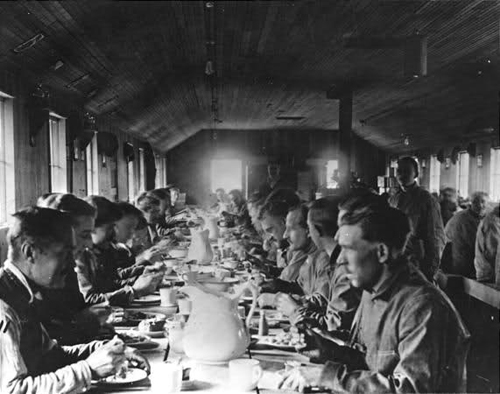
In 1916, it was decided that Fort Douglas, Utah would be the site where all prisoners of war, including civilians, would be in the custody of the War Department. In May 1917, it was announced as part of War Department General Order 54 that Fort Douglas would join Fort Oglethorpe and Fort McPherson in Georgia as internment camps for German prisoners of war. The Swiss Legation, as a neutral party, was tasked with inspecting all of these prisoner of war camps. In November 1917 their report of Fort Douglas stated: “The camp is clean and is kept in good order, thus giving a very pleasing appearance,” and “made upon the Commission the very best impression.” It was noted that the men were healthy, well clothed, had recreational opportunities, religious services, and barracks called, “the best we have inspected.” The commission, however, fielded innumerable complaints from the prisoners at the camp, yet many of the complaints were from the “enemy aliens” in the camp.
The SMS Cormoran II men arrived just after one o’clock in the morning on 10 June 1917 at the Denver and Rio Grande Railroad Depot in Salt Lake City and then took seventeen street cars from the Utah Light and Traction Company to the camp located just three miles outside of town. As described in the Utah Historical Quarterly:
The Salt Lake Tribune described the delivery of about 300 ‘enemy German prisoners’ on June 10, 1917, as a great spectacle without equal in Salt Lake City. The word of the day was ‘See the Germans!’ and thousands of curious ran to the streets to view ‘Teutons’ in the flesh.
Initially, the Cormoran crew would be sent to Utah, yet by the end of the summer (September 1917), it was already being noted that all military prisoners of war would be transferred to “War Prison Barracks #1” at Fort McPherson, Georgia. “Enemy aliens,” or German citizens that had been apprehended by the US in that camp, would be sent to “War Prison Barracks #2” at Fort Oglethorpe, also in Georgia.
Their new encampment at Fort Douglas, known as “War Prison Barracks #3” was relatively small yet much larger than the camps had been in Guam. A “double, high barbed wire fence” surrounded “an area of 748’ x 922’,” with an administration building atop a hill overlooking the entire prison. Officers had separate quarters than those of the enlisted personnel. By almost all accounts, the men were quite happy with the commander of the camp, Colonel George Byram, and the 130 men of the “Third War Camp Guard” under Captain Younglof. This is not to say the prisoners wanted to stay or that they did not test the American prison system at every opportunity.
Escape attempts, work stoppages, bomb plots, coded messages, riots, etc., plagued the camps in both Utah and Georgia. A multitude of separate tunnels were discovered at different times at Fort Douglas. The first two prisoners to escape were “enemy aliens” affiliated with the Industrial Workers of the World (IWW), or “Wobblies,” a radical labor union, in December 1917. Through inspections by the camp leadership and guards, seventeen tunnels and a bomb made by the internees were discovered by February 1918. It was believed that if the Wobblies were to continue to create problems that would involve a number of interned military, then the two groups should be separated by more than a fence—more distance, they believed, would solve all problems.
The awaited transfer to Fort McPherson, Georgia occurred in March 1918 with the Cormoran men joining the crew of the SMS Geier (originally interned at Honolulu) in making the journey via train. Fort McPherson, four miles southwest of Atlanta, had been a prisoner of war camp during the Spanish-American War, though its population with the addition of the Fort Douglas internees was soon to be much larger. Minister of Switzerland Hans Sulzer could not have been more comfortable with the news when he wrote the following to the United States Secretary of State on 27 March 1918:
I fully concur with your Excellency that this action will remove the causes of complaints which the Legation has been receiving so frequently of late from the prisoners of war and interned civilians at Fort Douglas, and I hasten to express to your Excellency my gratitude for this decision, which is entirely satisfactory to the Legation.
That same day, Carl Huebscher of “The Department of German Interests” at the Swiss Legation informed Captain Zuckschwerdt via letter of the decision to transfer the men; he hoped Zuckschwerdt would find this to be good news. However, this may have been a case of the “grass is always greener on the other side of the fence,” as the men of the Cormoran soon learned that their stay at Fort McPherson was to be quite different than that at Fort Douglas. Zuckschwerdt was constantly corresponding with the Swiss Legation for better treatment of his men and those of other ships as well. The United States and Germany soon both realized that mistreatment of the others’ prisoners could lead to mistreatment of their own prisoners in short order. Because of this, it appears that Fort Douglas may have been among the best prisons experienced by any prisoners during the First World War. Still, the transition was a challenge for some of the prisoners.
The Commandant of War Prison Barracks #1 at Fort McPherson, Colonel G.J. Van Orsdale, noted that “upon the arrival of the crews of the Cormoran and Geier, the dissatisfaction regarding the change from Fort Douglas was manifested in many ways.” They certainly were not the Colonel’s only problem prisoners, as ten members of the SMS Prinz Eitel Friedrich and other vessels escaped within two weeks of their arrival, with some of the officers making it as far as Laredo, Texas and New York City.
Some minor incidents involving non-Cormoran personnel also occurred and then a couple of Cormoran officers were shot by a sentry at the camp while walking around the inside perimeter of the fence. By their own account, Hans Buhr, Erich Rockholtz, Hans Berg, and Freidrich Spincken were “having an evening stroll” when Buhr tripped over a small gravel pile; over their laughter they heard a shout of “Get Away!” followed almost immediately by a shotgun blast. Both Cormoran officers, Buhr and Rockholtz, received wounds to their lower extremities that were treated at the hospital by their own surgeons. An investigation into the matter indicated they were too close to the camp fence and the sentry alerted them three times before purposefully shooting low to avoid injuring them worse. His fear was that a large group of men nearby were preparing to rush a gate that had no wire across the top. The sentry, Sentinel Albert Pryor, feared the action of the officers was a test to see if any sentry was watching before the group put their plan into action. They may very well have been attempting to escape; these same men would be caught doing just that in the future via tunneling.
Another prisoner was shot shortly after this incident. Ten men were playing on the ball field when their ball hit the wire. One of the players, Heinrich Knappke, ran after it and the guard, seeing a prisoner running toward the fence, fired and killed him. The combination of the various shooting incidents flustered the prisoners who indicated to the Swiss Legation that they no longer felt safe which may have led to the most unsavory performance by the Cormoran men since their internment.
Captain Zuckschwerdt and some other Cormoran men seem to have been fully involved in an infamous escape attempt from the Officer’s Barracks itself. In May 1918, a tunnel measuring 75 feet in length, four feet in diameter with planking and an electrical warning system was discovered under their building. An informant later told Commandant Orsdale that the men hoped to complete the tunnel so certain people could escape, yet felt they would only be successful if the tunnel were discovered and because of its discovery, Orsdale would be removed by his leaders in Washington. Lt. Otto Portwich was already awaiting court-martial for an escape attempt at Fort Douglas in March; the US State Department was threatening harsh penalties for his attempted escape if the Germans did not release American Paul Nagel whom they had been holding in Brandenburg for six months already for the same offense. Although Portwich tried to take full blame for the May incident as well, the following men (including Hans Berg who had made it to Texas six months prior to this incident) were placed in the disciplinary barracks for a number of days:
| Zuckschwerdt | 25 days |
| Grasshof | 8 days |
| Berg | 23 days |
| Collman | 23 days |
| Engelbrecht | Over 26 days at time of report (Court-martialed) |
| Paczensky | Over 30 days at time of report (Court-martialed) |
| Portwich | Over 30 days at time of report (Court-martialed) |
| Clausen | 15 days |
| Gebhard | 8 days |
Inside the tunnel, there were civilian clothes, tin cups, etc., that had to have been brought into the camps from the outside. It was reasoned that someone from outside the camp or an insider was supporting the men, yet no evidence exists that the person or persons were ever discovered. Orsdale indicated that “an assault [was started] on certain prisoners deemed not loyal to the German Government.” There was fear within the prison that the Swiss Legation would get involved on the part of the prisoners to force the removal of the camp leadership, yet this fear was unwarranted and the legation seems to have ignored the prisoner complaints.
End of World War I and beyond…
In the end, the armistice between the Allied Forces and Germany was signed on 11 November 1918. Actual fighting stopped, yet six months of talks at the Paris Peace Conference were needed before the actual peace treaty, the Treaty of Versailles, was signed. The long war of the Cormoran prisoners who had been among the first Germans interned by the United States of America was finally coming to an end. Over seven months after guns fell silent in Europe, the population of Fort McPherson was still 1,346 prisoners, yet there were now plans to send them north to ships that would carry them home.
At Atlanta, Georgia they boarded a special train with 200 American soldiers guarding them and their valuables. There were nine cars of baggage alone and it was said that the prisoners had considerable sums of money earned from their salaries and from the sale of handicrafts, etc., during their confinement. Finally, on 26 September, 1,253 prisoners left Hoboken, New Jersey bound for Rotterdam, Netherlands aboard the SS Pocahontas. During the voyage, Zuckschwerdt spoke with an officer of the ship who noted that the captain “talked freely of his stay in Guam before the United States entered the war and appreciated the treatment he received there from the Naval Officers after he had blown his ship up rather than surrender it…He said he would always remember the words with which Captain Cronan greeted him when he surrendered aboard the Receiving Ship – ‘Sir, you are a brave man.’” Arriving at Rotterdam on 8 October, the troops were assembled in a warehouse where they were fed and handed pamphlets that wished them well on the journey back to Germany. They left by rail and crossed into Germany at the border station of Wesel.
Not all of the Cormoran sailors would board the SS Pocahontas. Up to 150 Germans applied to become naturalized American citizens, yet only 75 applications were granted and these were only for probationary citizenship. Two of the Cormoran sailors, Erich Johannes Fratzscher and Walter August Engelbrecht, applied for citizenship together and had it granted to them on the same date—29 June 1925. Each of them was sponsored by George W. West and Stephen J. West of West Lumber Company in Atlanta, Georgia (a company that is still in existence today); both had married during their wait for citizenship; each had a young child; and they both signed affidavits swearing no further allegiance to the German Empire. Engelbrecht had spent time in the brig for his part in the attempted escape at Fort McPherson, yet was granted citizenship anyway. Sadly, Mrs. Kaete Fratzscher passed away in December 1926 and Fratzscher moved into the home of the Engelbrecht family on a farm owned by the two men. An article written ten years after the war in 1929 mentioned the great success the two former crew members were having as farmers on their 30-acre farm. They indicated it was a skill they had learned in prison at Fort McPherson.
Captain Adalbert Zuckschwerdt would travel extensively to the United States after the war. Though he lived in Berlin with his wife Penelope, he continued to visit the US listing himself as a “Captain” or “Director” at various times. His business during the interregnum between wars was in the fur trade. His friend, Arthur Maeser, ran Maeser Fur Farms with ranches in Minnesota, Canada, Alaska, and Germany; hence many of Zuckschwerdt’s visits were to Minnesota to see the operations there. The corporation went into voluntary receivership in 1936; this corresponds with the last known visits of Zuckschwerdt to the United States. He rejoined the German Navy in World War II as Rear Admiral with responsibility for the Loire/French South Coast command where he would earn the Silver Cross. He died shortly after Germany’s defeat in World War II.
An impassioned letter from Eleanore Blain Gebhard and Ilse Von Elpon was sent in 1917 to the Swiss Legation concerning the women’s inability to see their husbands and the libelous innuendo in the local press about the women and their imprisoned husbands. The letter stated in part:
Both Mrs. Von Elpons and myself would gladly share our husbands’ internment under any conditions, but as this seems impossible, we are most anxious for the War Department to grant us a definite time and number of hours for visiting, in order to avoid the unpleasantness which has always attended our request for interviews with our husbands, and which will give us a definite claim to see them.
The women were living in an apartment together in Salt Lake City; both were American citizens whose marriages had been interrupted by the war and they had faced a tormenting media storm since arriving in Utah. A copy of one of the newspaper editorials had this to say about the visits to their husbands:
Only a short time ago a couple of women, who call themselves American’s, were allowed to beslobber two of the men who have been known to be implacable enemies of our very selves in Salt Lake. What would happen to an American woman in Germany if she were to visit an American prisoner? The vacant state of a wall and the bullet would probably be her fate … It’s up to the government to stop this joy-gathering idea of the men in charge of the intern camp.
The Gebhards would make it through the war. They eventually moved to Cologne, Germany, and returned at least once in 1937 on the SS Hansa out of Hamburg to visit Eleanore’s brother in Pennsylvania for a month. Karl was still working for the German state as he listed himself as a “state official.” With his law degree and his knowledge of English and the American military system, he would have been an asset to any country.
The Von Elpons did not leave as good of a trail. Werner Robert Gustav Von Elpons was mysteriously signed on as a Seaman (although he was a ship captain by this time and may have just been getting passage back to Europe) in New York in 1929 for a vessel bound for Cherbourg. Not much else is known, except that he died in Berlin at the age of 78 in 1955.
Ernst Adolf joined the German Navy in 1912 ostensibly to get to Australia to “jump ship,” yet became a prisoner like the others from the Cormoran. He would receive excellent treatment throughout his incarceration. As Fort Douglas Research Archivist Su Richards states:
Mr. Adolf returned to the United States in 1925 and remained until his death in 1988. He never became a US citizen, preferring instead to be known as a ‘Citizen of the World.’
Ernst Adolf’s daughter Dorit and her husband Jim Mathers researched his story and unveiled one more member of the Cormoran crew to history while speaking with Fort Douglas’s museum about his life. Additionally, she recounted through correspondence with Guampedia that her father Adolf actually had returned to the US with his first wife, but she was not happy living in America and decided to return to Germany in 1931. Adolf did not go with her. Dorit Mathers expounds further, “I am sure that if he had [returned to Germany] he would not have lived through the Nazi regime, as he was extremely against them and would have been sent to a camp for extermination.” Adolf had met Dorit’s mother around 1936 in New York.
These men were almost all fluent in English and German by the end of the war. They were sent back to a destroyed nation in search of young men after losing so many during the war. Sadly, Germany would choose to rise again and use their strength to do unspeakable things less than twenty years after these men left prison. This group of sailors would have been men in the prime of their life just as Nazi leader Adolf Hitler came to power in their country.
Sank but not forgotten
The SMS Cormoran II was not forgotten. The US military dove upon the wreck immediately after its sinking and removed its armaments. As time passed and the first modern diving equipment was created and made available to the general public, adventurers in the early days of the sport set out to find the ship. Herbert Ward probably dived the area the most in the 1960s and 1970s, retrieving numerous items from the vessel with each dive. Ward later published The Flight of the Cormoran in 1970 and retold the story of the German ship and its crew in their journey to and in Guam. The book was recently republished by his daughter for a new generation of readers to rediscover the story of the Cormoran.
When the Tokai Maru, a Japanese transport vessel was sunk in World War II, it came to rest alongside the Cormoran, making Apra Harbor the site of two vessels from two world wars. The area has been listed with the National Register of Historic Places since 1975. In addition, an obelisk was erected in the US Naval Cemetery in East Hagåtña, near the graves of six crew members in honor of those who died on the Cormoran during its scuttling.
For further reading
Ancestry.com. “California, Passenger and Crew Lists, 1882-1959.” Immigration & Travel, 2008.
–––. “New York, U.S., Arriving Passenger and Crew Lists (including Castle Garden and Ellis Island), 1820-1957.” Immigration & Travel, 2010.
Auckland Star. “The Sinking of the Cormoran.” 10 October 1914.
Baker, Newton D. “Correspondence between US Secretary of State and American Legation, Berne, Switzerland.” Washington, DC: United States State Department, 4 March 1918.
—––. “Correspondence from Secretary of War Baker to Secretary of State Lansing.” Letter. Washington, DC: War Department, 11 June 1918.
–––. Secretary of War Baker to Secretary of State Lansing for transmission to Swiss Legation. Washington, DC, 18 September 1918.
Ballendorf, Dirk Anthony. “The Shot Not Heard Round the World: S.M.S. Cormoran and the German/American Confrontation at Guam During World War I.” In Selected Papers from the 1992 (59th Annual) Meeting of the Society for Military History Hosted by the Command and Staff College of the Marine Corps University. Edited by Donald F. Bittner, 95-116. No 3 of the Perspectives on Warfighting. Quantico: CGSCF, 1994.
Boland, Micajah. A History of the War Activities of the USS Pocahontas. New York: Press of Joseph D. McGuire, 1919.
Brainerd Daily Dispatch. “Receivership of Fur Farm Sought in Two Petitions.” 14 January 1936.
Camp, Dick. The Devil Dogs at Belleau Wood: US Marines in World War I. Minneapolis: Zenith Press.
Daniels, Josephus. “Letter to Count J.H. von Bernstorff.” Correspondence from Secretary of the Navy to German Ambassador. Washington, DC: United States Navy, 17 February 1916.
Giordani, Paolo. The German Colonial Empire: Its Beginning and Ending. Translated by Gustavus W. Hamilton. London: G. Bell and Sons, 1916.
Guthrie, George. “Letter to State Department.” Correspondence regarding SMS Cormoran. Tokyo: State Department, 13 April 1916.
Hans Sulzer. “Correspondence between Minister of Switzerland and Robert Lansing, United States Secretary of State.” Washington, DC: Legation of Switzerland, 26 September 1917: 2.
Honolulu Star-Bulletin. “Cormoran’s Captain Threatened with Lynching by German Crew.” 4 June 1917.
Huebscher, Carl P. Report on the Third Inspection of the War Prison Barracks at Fort McPherson, Georgia. Washington, DC: Legation of Switzerland, 1918.
Huebacher, Carl P., and Charles Vuilleumier. Report on the Inspection of the War Prison Barracks, at Fort Douglas, Utah, by the Swiss Commission for the Inspection of War Prison Camps in the United States. Washington, DC: Swiss Legation, 1917.
Iyenaga, Toyokichi. “What is Kaiochau Worth?” The Independent (S.W. Benedict), October 1914: 128-131.
Kingsport Times. “Germans Once Held at Atlanta Now Prospering on Farm There.” 13 October 1929.
Lochner, RK. The Last Gentleman-of-War: The Raider Exploits of the Cruiser Emden. Annapolis: Naval Institute Press, 2002.
Moore, John Hammond. The Faustball Tunnel: German POWs in America and Their Great Escape. Annapolis: Naval Institute Press, 2006.
Nagler, Joerg A. “Enemy Aliens and Internment in World War I: Alvo Von Alvensleben in Fort Douglas, Utah, a Case Study.” Utah Historical Quarterly 58, no 4 (Fall 1990): 388-405.
New York Times. “1,300 Germans Going Home: Interned Sailors on Way Here with Nine Cars of Souvenirs.” 24 September 1919.
Polk, Frank. “Correspondence to Attorney General.” Department of State, 2 October 1916.
Powell, Allan Kent. 1984. “The German-Speaking Immigrant Experience in Utah.” Utah Historical Quarterly 52, no. 4 (1984): 304-346.
Richards, Su. “The Fort Douglas Museum – A Prisoner’s Journey.” Utah Minuteman (Fall 2002): 42-43.
Rogers, Robert. Destiny’s Landfall: A History of Guam. Honolulu: University of Hawai’i Press, 1995.
San Francisco Chronicle. “Crew of Cormoran to Be Imprisoned.” 9 June 1917.
–––. “Governor Orders Compulsory Military Training in Guam.” 25 March 1917.
Shipler, Harry. “Fort Douglas, German Prisoners.” Photo number: Shipler #18161. Utah State Historical Society, 27 August 1917.
–––. “Fort Douglas, German Prisoners.” Photograph. Utah State Historical Society, 27 August 1917.
Sondhaus, Lawrence. World War One: The Global Revolution (Google eBook). Cambridge: Cambridge University Press, 2011.
Spennemann, Dirk HR, ed. “Marshall Islands History Sources No. 30: Itinerary of the German Cruiser S.M.S. Cormoran, 1902-1914.” In Digital Micronesia–Marshall Islands–An Electronic Library and Archive, last modified 9 October 2005.
Sulzer, Hans. “Correspondence between Minister of Switzerland to Secretary of State.” Letter. Washington: Legation of Switzerland, 28 March 1918.
Taylor, John M. “Karl Friedrich Max Von Müller: Captain of the Emden During World War I.” HistoryNet, 17 May 2007.
US Department of State. “Editorial: ‘Keep Americans on Guard’.” In Records of the Department of State Relating to World War I and its Termination, 1914-1929. Washington, DC: NARA, 5 August 1917.
Ward, Herbert T. The Flight of the Cormoran. New York: Vantage Press, 1970.
Zuckschwerdt, Adalbert. Correspondence with the Swiss Legation. Fort Douglas, Utah, 6 May 1918.

